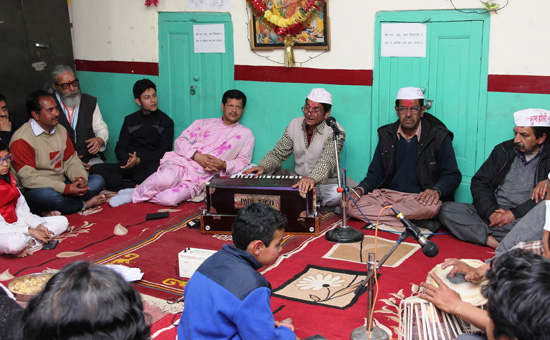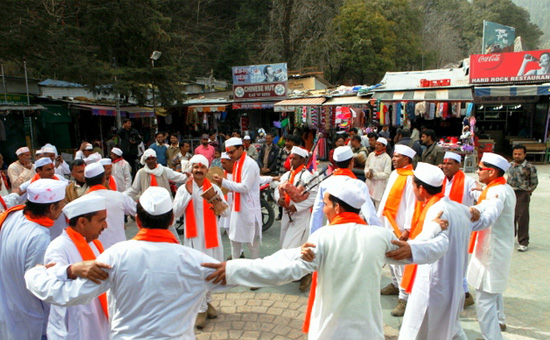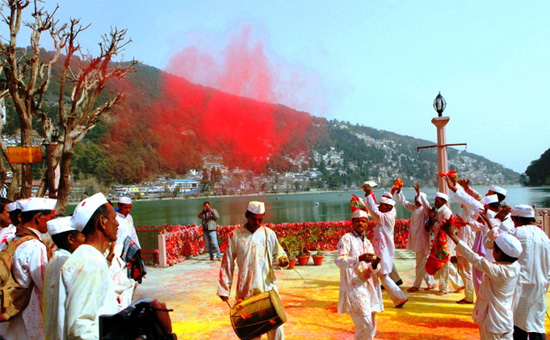Even as Holi festivities in the Mathura-Vrindavan belt of Uttar Pradesh are especially famous, the celebrations in the Kumaon Anchal region of Uttarakhand too are very well-known. The festival of Holi here is a kaleidoscope of lively colours and earthy folk songs – a veritable reflection of the vibrant and rich local culture.
In Kumaon Anchal, you can see three different types of Holi celebrations – Baithi Holi, Khadi Holi and Mahilaon ki
Holi (or Women’s Holi).
 Baithi Holi being celebrated with music and songs. Pic by Sri Sanjay Sah
Baithi Holi being celebrated with music and songs. Pic by Sri Sanjay Sah
Baithi Holi
As
this form of Holi is celebrated with music and songs mostly in urban
environments, it is also known as Naagar
Holi (or ‘urban Holi’). In ‘Baithi Holi’, groups of around five-to-seven or more people come together at temples, community centres or homes and sing songs. Musical instruments such as harmoniums, tablas, manjiras and dholaks are used as accompaniments for these songs. The sumptuous festive pahadi fare served to everyone includes
preparations with spiced potatoes and singalas
made of semolina (sooji). The meal is
finished off with nuggets of jaggery, betel leaves and areca-nuts (paan-supari), cloves and cardamom.
People get together to sing songs in villages and cities, homes and other places for ‘Baithi Holi’ from the first Sunday of the Hindu month of ‘Paush’ (corresponding with December/January in the Gregorian calendar). These musical celebrations move into a higher octave post ‘Basant Panchami’, which marks the arrival of spring. It is popularly believed that the tradition of singing songs on ‘Baithi Holi’ began around 250 to 300 years ago and this tradition was an important aspect of Holi celebrations in the royal court then.
Singing songs on ‘Baithi Holi’ transcended the royal court to the common people from the beginning of the nineteenth century. It is believed that the first such get-together happened at Hanuman Mandir at Malli Bazaar in Almora.
In
present times, local cultural institutions such as The Hukka Club are working
towards taking this rich tradition forward. In Almora, starting from the first
Sunday of the Paush month (December/January) to the full-moon day of the Phagun
month (February/March), people come together to sing songs and enjoy this
unique form of Holi celebrations.
Cultural associations such as Sharada Sangh, Nainital Samachar and Yugmanch in Nainital, Himalaya Sangeet Shodh Samiti in Haldwani, Sri Ramleela Samiti in Paudi and Kurmanchal Parishad in Dehradun are among some of the institutions that organise ‘Baithi Holi’ every year in the Kumaon Anchal region, keeping this ancient tradition alive.
 Khadi Holi being celebrated in white kurta pujama. Pic by Sri Anoop Sah.
Khadi Holi being celebrated in white kurta pujama. Pic by Sri Anoop Sah.
Khadi Holi
‘Khadi Holi’ or ‘Thaad Holi’ is celebrated in rural areas. Participation of common folks is prominent in these festivities. Music and songs on ‘Khadi Holi’ begin with the ritual of tying a piece of cloth around the branch of the ‘Padam’ tree (Wild Himalayan Cherry tree) and applying colours on Phalgun Ekadashi day and continue until the day after the full moon known as ‘Chaladi’.
‘Khadi Holi’ songs in Kumaon are sung only by the menfolk. The men gather in a circle and sing these songs. Importantly, their feet and hands move in sync with the rhythm of the songs. These singers are known as ‘holyaars’. Dressed in white-coloured kurtas and pajamas and wearing ‘topis’ (caps), the ‘holyaars’ go from one house to another and sing these songs. Percussionists, playing the manjiras and dholaks, perform amid the circle of the dancing ‘holyaars’. There are marked variations in the form and style of the music, influenced by local flavours, in different parts of the Kumaon Anchal region.
 Drawing by Nidhi of Ladies Holi. Pic by Nidhi Tewari.
Drawing by Nidhi of Ladies Holi. Pic by Nidhi Tewari.
Mahilaon Ki Holi (Women’s Holi)
In some parts of Kumaon Anchal, there is a tradition of Holi songs and celebrations exclusively by women. These songs are a combination of ‘Baithi Holi’ and ‘Khadi Holi’ styles. Instruments like manjiras and dholaks are used by women too. These Holi celebrations by women begin on Ekadashi day before Holi.
Having wrapped up domestic and farming chores, women enthusiastically participate in ‘Baithi Holi’. Humour and satire are also usually incorporated in these songs by the women. The songs feature satirical depictions of social events and humorous takes on family members and others in the
village such as parents-in-law, daughters-in-law, village elders, alcoholics
and politicians.
Different hues of Holi
Come Spring and the entire Kumaon Anchal region is drenched in the colours of the season. While the mountain peaks are capped in flaming red colour by the blooming Rhododendrons (‘Buransh’ flowers), the plains are covered in swathes of yellow mustard (‘Sarson’) flowers swaying to the cool breeze. Fruit trees such as Pears (‘Aadu’), Apricots (‘Khubani’), Pomegranates (‘Dadim’) and Himalayan Wild Cherries (‘Padam’) come alive with blooming flowers adding distinct streaks of pink and white around homes in the region. ‘Pyoli’ and ‘Kilmadh’ flowers add a bright yellow touch to the colourful vistas.
The vibrant hues of the season have a profound effect on the people in the region who then become one with nature and enthusiastically celebrate the festival of Holi with lively music and dance. ‘Khadi Holi’ songs begin on Ekadashi (11th lunar day) of the Shuklapaksha (waxing moon) in the Phagun month. On this day, branches of Wild Cherry trees (‘Padam’ trees) are cut and placed on the ground in temples and homes at an auspicious hour and colourful pieces of cloth are ritualistically tied around them. After the ceremonial worship of the branch, performers gather around it in a circle and begin their ‘Khadi Holi’ performance. The ritualistic tying of pieces of cloth around the branch is accompanied by this beautiful song hailing Lord Rama:
Kailyi baandhi ho cheer
Jai Raghunandanraja
Brahmaji baandhi cheer ho, Raghunandanraja
Vishnuji baandhi cheer ho, Raghunandanraja
Shivajyulai baandhi cheer ho, Raghunandanraja…
On Holi Ekadashi, temples as well as ‘puja’ spaces in homes are anointed with colours. People dress in white coloured clothes and play Holi putting colours on each other. Lord Ganesha is worshipped along with all other Gods and Goddesses and their blessings sought for the well-being and prosperity of families and villages. The following song is sung on this occasion:
Tum siddhi karo maharaj, hori ke din mein
Ganapatiji ji hainlakhabarees
Riddhi-Siddhi leke saath, hori ke din mein
Brahmaji ji hainlakhabrees
Vishnuji ji hainlakhabarees…
Everyone in the villages – young and old alike – get into the spirit of Holi. The sounds of the ‘dhols’ and ‘jhanjhars’ reverberate in the air filled with melodies of the Holi songs sung by the people in village temples. The whole milieu is rendered divine as though the Gods themselves have descended to sing songs and celebrate along with the ‘holyaars’. The popular song sung on these occasions is an ode to the river Ganga:
Kari tapasya ghanghor Bhagirath Ganga le aaye
Shiv ki jata mein Ganga behti hain
Kar Gangasnaan Bhagirath Ganga le aaye
Parbat phaadi gaumukh nikali
Haridwar mein aaye Bhagirath Ganga le aaye…
Holi
is also the time for fun and merriment in the hilly regions, especially as the
festival marks the onset of the spring season. Songs full of cheerfulness and
celebration of youth and beauty are sung with a lot of gusto. A popular folk
song asking bees to fly away from flowers is sung during this time:
Udi jaa bhanvar toke maarenge
Udi-udi bhanvara bagiya mein baithe
Phoolan ker saleya bhanvar toke marenge
Udi-di bhanvara syunnin mein baithe
Syunnin ker saleya bhanvar toke marenge…
The
Holi songs cover a plethora of emotions including the pathos of a young bride
whose heart pines for her husband who is away from the village. The onset of spring
and the festival of Holi makes her even more restless and anguished at the
separation. She adorns colourful clothes and jewellery and prepares a delicious
feast as she eagerly awaits his return. She opens her heart to her friend in
this song:
Balma ghar aaye phagun mein
Jab se piya pardes sidhaare
Aamal gaaye baagan mein
Sundar tel phulel lagaayo
Syonishringaar karaavan mein
Bhojan-paan banaayeman mein
Laddoo-peda laavan mein
Aaye piya harshbhai hun
Mangal kaaj karaavan mein
Balma ghar aaye phagun mein…
 Celebrating Holi on the banks of the Naini Lake in Nainital. Pic by Sri Anoop Sah.
Celebrating Holi on the banks of the Naini Lake in Nainital. Pic by Sri Anoop Sah.
The ‘Holika’ fire is lit on the night of the full-moon (‘Purnima’). Holi is celebrated with colours and water on the following day, called ‘Chaladi’. On this day, the ‘holyaars’ visit homes and shower blessings on families. The ‘teeka’ ritual is done on the day after Chaladi. People gather at temples in the villages to worship the deities and ‘halwa’ is offered as ‘prasad’ to everybody. With this ritual, the ‘holyaars’ bid farewell to the festival and await its return in the following year.
Gaavain khele dev aasheesh, hoho holak re
Baras Diwali barsai phaag,
Hoho holak re
Jo narjeevain khele phaag,
Hoho holak re…
Special Characteristics of Kumaoni Holi
One
can see specific influences of the Kumaon Anchal region in the Holi
celebrations of this place. The festival of Holi, having originated in the
Braj-Avadh belt of Uttar Pradesh, spread to the hilly regions of Uttarakhand
and slowly began to assimilate local flavours and influences which have given
it a distinct form. Over time, folk culture and lore blended seamlessly into
the spirit of the festival. This distinct form of Holi, resplendent with regional
nuances, is today an important cultural legacy of Kumaon Anchal.
1
The period of ritual singing of Holi songs: Ritual singing during the Holi festival, in the form of ‘Baithi Holi’, begins in the Kumaon region from the first Sunday of the ‘Paush’ month and continues through the month of ‘Phalgun’ until the day after the full-moon night, called as ‘Chaladi’. In some parts, the ritual singing continues even after Holi until the first month of the Hindu New Year, ‘Chaitra’ (April/May) or in some cases up to ‘Ram Navami’.
Songs sung before Basant Panchami are typically devotional and spiritual in nature, while the songs after that take on more colourful and ornate themes. ‘Khadi Holi’ songs begin with the planting of the branches of the Himalayan Wild Cherry trees (‘Padam’ trees) in public places covered with colourful pieces of cloth on ‘Phalgun Ekadashi’ day, after the ritual of ‘rang-anushthaan”.
This
long period of ritual singing during Holi is unique to the Kumaon region and
possibly cannot be seen anywhere else.
2
Different types of ritual singing: In Kumaon, ritual Holi singing involves three distinct forms – ‘Baithi Holi’, ‘Khadi Holi’ and ‘Mahilaon ki Holi’. All three forms have been elaborated in detail above.
3
Simplified music compositions in ‘Baithi Holi’: Songs sung in ‘Baithi Holi’ are based on classical ‘raagas’, but the style of singing makes it easy for even those who do not know or understand classical music. The compositions are simple and can be sung by one and all.
4
Holi songs rooted in nature and spirituality:
These Holi songs touch upon various emotions and give important spiritual and
social messages to listeners. While the songs that are devotional in nature
exhort one towards attaining spiritual experiences, the songs themed around the
colours of the season are breezy and enjoyable adding to the enthusiasm and
festivities.
5
Socio-political influences of the Holi songs: Often
Holi songs have incorporated powerful socio-political messages. This is a salient
aspect of Holi in this part of the country.
Poets
like Gauri Datt Pande (also known as Gaur Da), Girish Tiwari (also known as
Girda) and Charu Chandra Pandey have composed well-known Holi songs that have
had a deep social impact in the region. These songs have played an important
role during the freedom movement including the Forest Satyagraha and for other
social causes such as the movement against alcoholism in the region.
6
Holi – symbol of equality and brotherhood: Traditionally, Holi celebrations have marked the coming together of different communities, oneness and brotherhood. Even today, villages in the hilly regions of Kumaon celebrate Holi collectively and ‘holyaars’ visit homes not only in their own villages but in the neighbouring villages as well.
People
from the region who have settled in other cities like Lucknow and Delhi also
celebrate the festival in the traditional way. Many people also travel back to
their homes, in the hills, to take part in the traditional rituals and
celebrations.
7
The unique tradition of showering blessings: When ‘holyaars’ visit homes in the region to sing Holi songs, the chief ‘holyaar’ blesses every member of the family. These blessings epitomise the principles of “Vasudhaiva kutumbakam” and “jeevet Sharadah shatam” symbolising the Indian ethos of oneness with nature, fostering the well-being of all. Heads of families and other members, young and old, are blessed with happiness, good health, divine grace and well-being. The ‘holyaars’ also wish that the spirit and gaiety of the spring season remains in these homes throughout the year.
Author is Research Associate at Doon Library and
Research Centre, 21, Parade Ground, Dehradun, Uttarakhand.
To
read same article in Hindi. This article is an English translation of the
Hindi article. Dhanyavad and Nandri to Lakshmi.
Also see pictures of Holi
1 Lathmar Holi Barsana near Mathura
2 Lathmar Holi Nandgaon near Mathura
3 Holi Manipur
4 Holi ka Dahaan City Palace Udaipur
5 Hola Mohalla Anandpur Sahib
6 Ladoo Holi Barsana